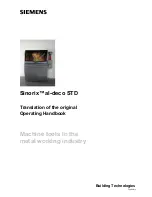
- 12 -
OPERATIONAL TIPS
OPERATIONAL TIPS
After reading the previous chapters carefully,
apply these tips scrupulously to obtain maximum
performance.
Proceed calmly so as to become familiar with
all the controls; after having gained sufficient
experience you will be able to make full use of
its potential.
ABRASIVE SUPPORT
Use the suitable abrasive support for the sanding
operation to be carried out. The choice depends
on the material to be processed and the required
finishing degree; there are different types on
the market marked with a number defining the
surface “grain”, printed on the back. Ask your
retailer to give you the best advice on this. Our
company produces a wide range of abrasive
supports suitable for the various uses.
Material
Operation
Grain
Numero
Wood, me-
tal, plaster,
paint, pla-
stic
Roughing out
with rough fi-
nish
Coarse
40
60
Sanding with
medium finish
Medium
80
100
120
Sanding with
fine finish
Fine
from 150
to 400
Polishing
Very fine
600 and
over
SANDING OPERATION
- Before working on important objects (e.g. furni-
ture, vehicles, etc.) do a sanding test to ensure
you have installed the right abrasive support.
- If the item is small and light always fasten it
with a vice while working; if it is not fastened
well, the action of the machine could throw it
against you.
- Do not work on damp or wet items or with wet
abrasive supports.
- Initially use an abrasive support with a coarse
grain (e.g. 40), then finish processed surfaces
with a finer grain abrasive support (e.g. 120
or higher).
- Make sure the abrasive support is correctly
assembled and perfectly flat against the orbital
plate.
- Always use the sander connected to a vacu-
um system with a filter for dust or to the bag
provided.
- Only start the sander once you have a firm
grip on the handle(s). Rest it on the item and
operate it with circular movements exerting
light pressure. Do not insist on sanding one
point keeping the machine still.
- Excessive pressure with the hand(s) on the
sander does not improve its performance and
causes a risk of the motor overheating with
subsequent breakdowns not covered by the
warranty, or can cause fire due to the high
temperatures produced on the item.
- Do not cover the sander’s ventilation slots with
your hand(s).
- Replace the abrasive support as soon as it
is worn or deteriorated; do not let the sander
work under excessive loads, avoid damaging
the backing plate and you will obtain a better
result with less effort and time.
MAINTENANCE
!
IMPORTANT! Before any inspection,
adjustment or maintenance, always discon-
nect the battery from its housing.
!
IMPORTANT! Do not tamper or attempt to
repair the electrical tool.
The working life and costs also depend on con-
stant and meticulous maintenance.
Take good care of your electrical tool and clean it
regularly. In this way its efficiency will be ensured
and its lifespan extended.
- Remove dust and machining residuals with a
brush with soft bristles.
- Do not wet or spray water over the electrical
tool - risk of internal infiltrations.
- Do not use any inflammables, detergents or
solvents.
- The plastic parts can easily be damaged by
chemical agents.
- Do not use compressed air for cleaning: Risk
of material ejection!
- Pay particular attention to cleaning the switch,
the motor ventilation slots, the holes on the
backing plate and the abrasive support driving
rollers.
- Open the dust box cover (fig. G) to empty the
contents. Clean the inside with a small brush
and reassemble.
- Remove any traces of wood resin.
Summary of Contents for M-LP 18
Page 2: ...2 A B 2 5 4 1 8 7 6 4 2 3...
Page 3: ...3 C F G D E 1 b a 8 a b...
Page 9: ...9...
Page 15: ...15...


































